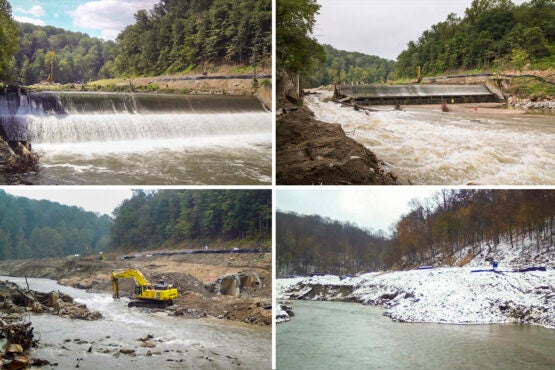$2.3 billion to improve or remove U.S. dams included in new federal infrastructure bill in wake of a Stanford Uncommon Dialogue agreement
Key ideas and proposals from an agreement between the hydropower industry and environmental community, facilitated through a Stanford Woods Institute for the Environment Uncommon Dialogue, have been included in the $1 trillion infrastructure package adopted by the U.S. Senate.
In the fall of 2020, amidst a global pandemic and one of the most divisive periods in American history, the hydropower and river conservation communities, traditionally at odds, reached an agreement to work together to address the nation’s more than 90,000 dams.
The momentous agreement was the result of a two-and-a-half-year Uncommon Dialogue, an ongoing process organized by the Stanford Woods Institute for the Environment that brings public and private sector leaders and researchers together to develop practical solutions to pressing sustainability challenges.
Now, key ideas from that pact, and a subsequent detailed proposal, are incorporated into the bipartisan Senate infrastructure bill, including $2.3 billion for the “3Rs” of U.S. dams: rehabilitation for safety, retrofit for power and removal for conservation. If enacted, the pending infrastructure bill would be the largest new federal funding for infrastructure in decades.
Dan Reicher, a senior research scholar at the Woods Institute and a former U.S. assistant secretary of energy, leads the Uncommon Dialogue on “Hydropower: Climate Solution and Conservation Challenge.”
“It was a risky idea and a heavy lift but it is exciting to see our breakthrough 3Rs agreement turned into a significant federal down payment on the massive funding needed – measured in the tens of billions of dollars – to address serious problems and major opportunities at the nation’s dams,” said Reicher, who is also the founding executive director of the Stanford Steyer-Taylor Center for Energy Policy and Finance and former director of Climate and Energy Initiatives at Google.
As outlined in the October agreement, the goals of the 3Rs are to help confront climate change, increase the safety of U.S. dams and improve the ecological health of the nation’s rivers. To that end, the $1 trillion infrastructure bill, which the Senate adopted on Aug. 10, includes $753 million for safety and environmental improvements at existing hydropower facilities, adding hydropower generation to dams that currently do not produce power and for “pumped storage” projects; $800 million for rehabilitation and repair of high hazard dams and safety projects; and $800 million for the removal of dams in the interest of safety and the environment.
“Hydropower is a critical component of our ability to address climate change, but we can’t emphasize hydropower over the health of rivers or the safety of the public. The 3Rs effectively advance all three objectives at the same time,” said Woods Institute director Chris Field.
Next steps for infrastructure
The bipartisan Senate infrastructure bill is currently being considered in the House, where tensions have been high on how to move forward on the bill and whether to wait for action on a broader $3.5 trillion budget bill. On Tuesday, House Democrats voted to allow committees to begin writing the $3.5 trillion budget bill and also set a deadline of Sept. 27 for the House to pass the infrastructure legislation.

The Bloede Dam on the Patapsco River in Maryland was removed in 2019. This sequence of photos (from top left to bottom right) shows different stages of the dam removal process. (Image credit: Maryland Fisheries Service DNR)
On top of this, bipartisan Senate and House bills have recently been introduced that would multiply 3Rs spending in the pending infrastructure legislation by 10-fold, which, if enacted, would address the safety, environmental and climate challenges of U.S. dams on a massive scale.
“We are encouraged by the inclusion of the 3Rs in such important federal legislation and hopeful that these proposals will ultimately be part of an enacted bill,” Reicher said.
To get a sense of the potential impact of the 3Rs, below are examples of U.S. dam retrofits, rehabilitation and removal:
Retrofit
Out of the more than 90,000 U.S. dams, only about 2,500 produce electricity. Retrofitting existing dams to produce electricity can help increase clean energy generation without the negative environmental impacts of building new dams. Retrofitting existing dams could add as much as 12,000 megawatts to the grid, according to a U.S. Department of Energy report.
One example of retrofitting is the recently completed Red Rock Hydroelectric Project on the Des Moines River in Iowa, with 55 megawatts of added electricity generating capacity. The dam, originally constructed in 1969 for flood control, will now help power more than 18,000 homes and businesses in four states.
Rehabilitation
After heavy storms in 2017, 180,000 people were evacuated when the spillways at California’s Oroville Dam failed and severe erosion threatened to send a 30-foot wall of water toward communities below. Lake levels eventually dropped but the damage to the spillways was significant, requiring over $1 billion in repairs. Today, the California Department of Water Resources has rehabilitated the main and emergency spillways and strengthened the dam’s foundation. Had longstanding issues at the dam, the tallest in the U.S., been addressed through earlier rehabilitation, the costs would have likely been reduced and a critical safety issue requiring evacuation less likely to occur.
Removal
When a dam has significant safety risks or causes negative environmental impacts that cannot be effectively addressed – or is no longer serving a useful purpose – removal can increase public safety and reduce harm to river ecosystems.
Go to the web site to view the video.
The Bloede Dam on the Patapsco River in Maryland was originally a hydroelectric plant but had not generated any power since the 1930s. In addition to its negative impacts on fish passage and aquatic habitat, it was also a public safety hazard, with at least nine dam-related deaths since the 1980s.
The dam’s removal in 2019 opened up more than 65 miles of the Patapsco-Chesapeake watershed for spawning habitat for fish species like shad and herring. In addition, recreational opportunities, such as swimming, boating and fishing, are also on the rise. Earlier this year, biologists with the Maryland Department of Natural Resources found river herring species as far inland as Ellicott City, the first time those species had been found that far up the Patapsco in over 100 years.

